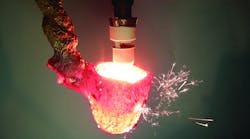SinterCast AB, the developer of a proprietary process control package for compacted graphite iron production, reports record-breaking results in revenues and earnings for 2015, as well as impressive progress in expanding the scope of its installations; six new Sinter Cast installation commitments were recorded last year, two in China, and one in each of Brazil, Japan, Portugal, and South Korea.
Except for the new order from Teksid do Brazil, all of these have been commissioned; the new Brazilian installation is expected during Q2 2016.
Compacted graphite iron is a lightweight alternative to gray iron that has been adopted by auto and truck builders for diesel engine blocks and cylinder heads. Lately, CGI has been adopted for some new gasoline engine models. Stockholm-based Stockholm-based SinterCast
is the world’s largest licenser of technology and supplier of production systems and products used by foundries to produce CGI. It reports a total of 44 installations in 13 countries.
SinterCast’s total revenues (production, sampling cups, installations) drove 2015 revenues to SEK 72.4 million ($8.57 million), an “almost 100% increase in the full year operating result,” according to the group’s release.
In his summary comments to the group’s year-end financial statement, president and CEO Dr. Steve Dawson noted that annualized series production of CGI by SinterCast licensees had grown 18% over 2014’s total to 2.1 “engine equivalents’ (1 = 50 kg), or 105,000 metric tons. The rise in series production also led to a 15% increase in shipments of SinterCast sampling cups, to a new record total of 152,700.
Whereas the growth of CGI has mainly been driven by passenger and commercial vehicle diesel engine programs (cylinder blocks, exhaust system parts), the latest trend driving new demand involves gasoline engines for passenger vehicles and light trucks. SinterCast cited 2015’s increase in series production supporting Ford Motor Co. gasoline engines, as well as continuing strong demand for 3.0-liter V6 diesel engines installed in Audi, Fiat Chrysler, and Ford vehicles.
The outlook calls for passenger vehicles to continue to be a strong driver of CGI demand, with new vehicle applications coming for the new Ford engine and with the start of delivery for a 5.0-liter V8 diesel engine in the new Nissan Titan pick-up truck.
SinterCast also pointed to growing demand for CGI for industrial diesel engines, as well as an all-new application in an aviation diesel engine produced by Engineered Propulsion Systems.
In addition to the progress of its compacted graphite iron technology, SinterCast reported it is making progress in its development of a customized thermal-analysis sampling device for ductile iron production. And, it noted without elaboration that it is developing other technologies, “within and beyond the scope of thermal analysis - to improve quality and production efficiency in the cast iron foundry industry.”










